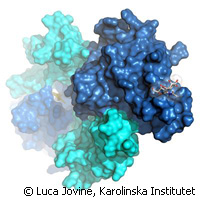Scientists piece together egg and sperm fusion puzzle
Researchers in Sweden have cracked the mysteries behind the fusion of egg and sperm at the beginning of fertilisation, successfully describing the 3D (three-dimensional) structure of an egg receptor. The results, published in the journal Cell, help fuel our understanding of infertility and could lead to development of new types of contraceptives. The research was funded in part by the ZP DOMAIN STRUCTURE ('Structure determination of the zona pellucida domain by X-ray crystalloghy') project, which clinched EUR 40,000 in a Marie Curie Actions - Human resources and mobility grant of the EU's Sixth Framework Programme (FP6). For centuries, people have been fascinated by the encounter of gametes, namely the egg and sperm, whose union results in the creation of a new organism. Scientists have understood that during this process, sperm binds to proteins in the extracellular coat of the egg called zona pellucida (ZP) in mammals and vitelline envelope (VE) in non-mammals. Until now, the molecular details of this fundamental biological event have remained obscure, but this is all set to change thanks to this latest study. Led by Luca Jovine from the Karolinska Institutet in Sweden, in collaboration with Professor Tsukasa Matsuda from Nagoya University in Japan and Dr David Flot from the France-based European Synchrotron Radiation Facility (ESRF), the researchers found the 3D structure of the receptor molecule that binds sperm, called ZP3. The detailed structural information, based on data collected at the ESRF, makes it possible for scientists to begin exploring at the molecular level how the egg interacts with sperm at fertilisation, according to the team. 'Thirty years after ZP3 was identified, this work yields structural information on an egg protein region directly recognised by sperm at the beginning of fertilisation,' the authors wrote. 'Combined with mutational and in vitro binding studies, the structure provides insights into many aspects of ZP3 biology, ranging from secretion and polymerisation to interaction with sperm.' The study suggests which parts of the receptor are likely to be directly contacted by sperm, and provides new insights into how the sperm receptor is assembled and secreted from the egg. 'The results give a remarkable picture of the female side of fertilisation,' said Dr Jovine. 'But this is, of course, only half of the story. The next step will be to tackle the corresponding molecules on sperm that allow it to bind to the egg.' The findings have important implications for human reproductive medicine, as they may explain how mutations in the sperm receptor gene could cause infertility, according to the researchers. Past studies have already shown that antibodies against ZP proteins can be 'powerful tools for inhibiting the fertilisation of domestic animals and wildlife, including primates'. Any advances in this domain would be welcomed with an estimated one in seven couples worldwide having problems conceiving. The research could also potentially lead to the design of non-hormonal contraceptives specifically targeting egg-sperm interaction, the team said. Such contraceptives could be an attractive alternative to the traditional birth control Pill that was developed 60 years ago, potentially having far fewer adverse effects. Some women who take the Pill complain of mood swings and nausea and are at higher risk of blood clots and high blood pressure. The researchers highlighted that 'no completely novel contraceptive method has been introduced in the last 50 years to address the continuous growth of the world population'.
Countries
France, Japan, Sweden



